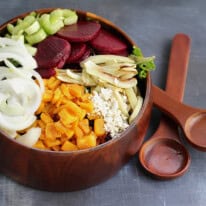Tips to Reduce Food Waste and Save Money
Looking to reduce food waste and do your part with sustainability? Here are tips from Sally, a mom and Registered Dietitian, on how to reduce food waste at home.
Did you know that over 40% of all food grown or produced in the United States is ultimately thrown away? That’s a lot of time and money going to waste!
There are several ways we, as families, can help reduce food waste in the kitchen. Wasting less is not only good for our budgets but also for the environment, since food in landfills releases greenhouse gas that contributes to global warming.
Here are a few ideas to reduce food waste in your home:
Meal Plan and Meal Prep
Starting from scratch with a meal plan each week can feel overwhelming–and lead to waste if your fridge and pantry are already well stocked. So look at what you have on hand and plan meals around those things first.
- Fresh berries about to turn? Plan for fruit smoothies at breakfast.
- Bunches of greens that need to be used? Pack lunch salads for work and school.
- Package of ground beef in the fridge? Put Taco Tuesday on your lineup.
If you’re new to meal planning, check out these 10 Beginner’s Tips to Meal Planning Like a Pro to get started.
Buy only the amount you need
The average family of four spends $1500 per year on food that goes uneaten, according to the EPA. It’s easy to get carried away when you’re at the store. That’s especially true at warehouse stores that make big packages seem like a bargain. Just be sure you’re actually going to use that portion. Otherwise, it’s just wasted money (and wasted food).
Having a meal plan for the week–even if it’s just your dinners for the week jotted down or one or two days sketched out–will help you know how much to buy.
Store food the right way
How many times have you tried to make a salad, only to discover that your greens were wilted and browned? How (and where) you store food in the fridge can make a big difference in how long that food lasts.
For instance, you should store highly perishable items like milk and eggs on the bottom shelf or near the back of the fridge, two areas that tend to be the coldest. Avoid stashing those items in the fridge door, which is often the warmest spot.
Here are some smart tips for storing fruits and veggies from the EPA:
- Put veggies like greens, broccoli, and cucumbers in a produce drawer set to high humidity.
- Place fruits (as well as easily-spoiled veggies like mushrooms and peppers) in a produce drawer set to low humidity.
- Remember that some fruits like bananas, apples, pears, and avocados produce a gas called ethylene that will ripen fruits and veggies around them. Keep these away from other produce.
- Store berries in the fridge unwashed, and rinse just before eating.
- Keep potatoes, onions, garlic, and squash in a cool, dry, ventilated place–not the refrigerator.
Label & Inventory
Freezing is a great way to extend the life of ingredients and tuck away food for the future. For instance, if a recipe makes more than your family can eat, freeze the leftovers to pull out and reheat for an easy meal. But freezing can backfire if you forget what you have (and when you put it in there)!
To avoid this, label what’s in your freezer with the name of the food and the date. Then use an inventory sheet to log it all. That way, you’ll know what to use up first when you’re meal planning to avoid freezer burn and waste. Here’s a free inventory printable for that.
You can check out some tips on Ways to Freeze Fruits & Veggies or these 6 Tips for Freezer Meal Success for more inspiration.
You can also label items in your refrigerator. Use a permanent marker to write the date the item was opened so you know how long something has been in your fridge. That will also help you determine if you should buy a smaller size next time.
Be smart about expiration dates
Product dating isn’t typically required by law, and it’s often more guidance than a hard-and-fast rule. For instance, “Best Buy” dates don’t have anything to do with food safety. Rather, the manufacturers believe their products would be the best quality if they’re consumed before that date.
“Sell Buy” dates are designed for stores. If you see that date on beef or pork, use it within 3-5 days of the Sell By date (1-2 days for poultry or ground meats), says the USDA. If you don’t plan to use it before then, freeze it. It will last several months that way.
As for eggs, they’ll keep up to five weeks in the fridge (even if the Sell By date expires during that time), and yogurt can last up to two weeks.
Use the FoodKeeper app to see the shelf life of common foods.
Rebrand Leftover Night
Build in a night to use up leftovers and other odds and ends at the end of each week. It’s one less meal to plan and cook (hooray!), reduces food waste, and saves money.
If your family balks at the word “leftovers”, rebrand it as “Smorgasbord Night” or “Friday Buffet”. Then pull things from the fridge and let everyone assemble the meal that sounds best to them. Everyone might be eating something different, but you can still enjoy family dinner together.
Save & Repurpose
The next time you’re tempted to toss something, think about whether it can be reused or repurposed. For example:
- Make homemade soup stock with vegetable scraps and leftover whole chickens
- Freeze overripe fruit for future smoothies
- Chop fresh herbs and freeze in ice cube trays with olive oil
- Turn the ends of bread into croutons or pulse in a mini-chopper or blender to make breadcrumbs
- Save ends of romaine lettuce and scallions and regrow them in water
- Use rinds of cheese like parmesan to flavor soups
Start a Compost.
Some leftover food scraps- like banana peels, carrot peels, apple cores, coffee grounds, and eggshells–can’t be repurposed in your cooking. But instead of throwing them away, put them to use in a compost pile. That way, you can avoid adding food waste to landfills and put nutrients back into your garden, lawn, and flower beds.
All you need to get started is a pail or bin in your kitchen for scraps, another one outside, and some patience as you wait for it to break down into “black gold”, as nutrient-rich compost is known to gardeners. Here’s a complete beginner’s guide to getting started with composting at home.
I hope these ideas to reduce food waste will help you make the most of your food purchases which will ultimately help you save money too!












